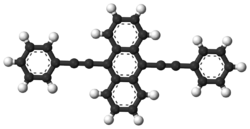Chemistry:9,10-Bis(phenylethynyl)anthracene
From HandWiki

| |

| |
| Names | |
|---|---|
| Preferred IUPAC name
9,10-Bis(phenylethynyl)anthracene | |
| Other names
9,10-Bis(2-phenylethynyl)anthracene, BPEA
| |
| Identifiers | |
3D model (JSmol)
|
|
| 1891432 | |
| ChEBI | |
| ChemSpider | |
| EC Number |
|
PubChem CID
|
|
| UNII | |
| |
| |
| Properties | |
| C30H18 | |
| Molar mass | 378.473 g/mol |
| Appearance | Orange needle crystals |
| Melting point | 252 to 258 °C (486 to 496 °F; 525 to 531 K) |
| Hazards | |
| Main hazards | Irritant (Xi) |
| GHS pictograms | 
|
| GHS Signal word | Warning |
| H315, H319, H335 | |
| P261, P264, P271, P280, P302+352, P304+340, P305+351+338, P312, P321, P332+313, P337+313, P362, P403+233, P405, P501 | |
Except where otherwise noted, data are given for materials in their standard state (at 25 °C [77 °F], 100 kPa). | |
| Infobox references | |
Tracking categories (test):
9,10-Bis(phenylethynyl)anthracene (BPEA) is an aromatic hydrocarbon with the chemical formula is C30H18. It displays strong fluorescence and is used as a chemiluminescent fluorophore with high quantum efficiency.
It is used in lightsticks as a fluorophor producing ghostly green light. It is also used as a dopant for organic semiconductors in OLEDs.

The emission wavelength can be lowered by substituting the anthracene core by halogens or alkyls. 2-ethyl and 1,2-dimethyl substituted BPEAs are also in use.
- 1-chloro-9,10-bis(phenylethynyl)anthracene emits yellow-green light, used in 30-minute high-intensity Cyalume sticks
- 2-chloro-9,10-bis(phenylethynyl)anthracene emits green light, used in 12-hour low-intensity Cyalume sticks
See also
- Lightstick
- Organic light-emitting diode
- 5,12-Bis(phenylethynyl)naphthacene
- 9,10-Diphenylanthracene
External links
- Absorption and emission spectra
- National Pollutant Inventory - Polycyclic Aromatic Hydrocarbon Fact Sheet
- Novel red-emitting BPEAs
 |

